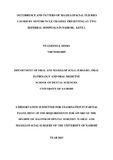| dc.contributor.author | Nyameino, J. Simba | |
| dc.date.accessioned | 2016-11-28T10:39:20Z | |
| dc.date.available | 2016-11-28T10:39:20Z | |
| dc.date.issued | 2016 | |
| dc.identifier.uri | http://hdl.handle.net/11295/97915 | |
| dc.description.abstract | Background:
Road Traffic Crashes (RTCs) constitutes a major public health concern especially with the evolution of transport systems and utilization of motorcycle as a means of transport, due to their affordability and convenience. Motorcycle use in Kenya has significantly increased over the last decade. RTCs involving motorcycles have also steadily increased over the years and this has consequently led to an increased burden in management of injuries to the health care system in Kenya. These injuries include cranio-maxillofacial and mandibular trauma. The pattern of maxillofacial injuries and use of protective gear is not well described.
Study Objective:
To determine the occurrence and pattern of maxillofacial injuries among patients involved in motorcycle crashes presenting for treatment at two referral hospitals in Kenya.
Study Setting:
The study was conducted at the Kenyatta National Hospital (KNH) and Mama Lucy Kibaki Hospital (MLKH) in Nairobi between 12th August 2014 to 30th November 2015
Study Design
This was a descriptive cross-sectional prospective hospital based study
Materials and Methods
Data were obtained through interview and physical examination of patients. A questionnaire was used to record patient’s biodata; age, gender and residence and treatment administered. Research assistants were trained to assist in data collection. Every tenth patient interviewed and examined by the research assistant was re-examined by the principal investigator to ascertain that the information acquired was accurate, consistent, reproducible and reliable. A sample size of 91 patients was achieved. Data analysis was done using an MS-Excel computer program and SPSS (Statistical Package for Social Sciences) version 16.
Results
Ninety one patients were examined, among whom 76 (83.5%) were males and 15(16.5%) were females (M:F 5:1). The age range and modal age were between 3-62 years and 21- 30 years respectively (mean=29years). Most of the participants were motorcycle riders and businessmen. Majority of the riders (84.2%) had no training or valid motorcycle riding licenses while a minority (15.4%) had a valid motorcycle license. The kind of protective gear used by the participants included the use of jackets (35%), helmets (32.9%), reflective coat (28.8%) and protective trousers (6.8%). There was a significant association between use of protective gear and occupation with motorcycle riders having higher rates of usage of protective gear. Most of the participants(98%) had soft tissue injuries, while (63.7%) of the participants had facial hard tissue injuries; the midface was the most commonly fractured site (38%). The concomitant injuries recorded were; upper limb, head, chest and abdominal injury. The midface fractures were significantly associated with helmet use and mandibular fractures with accident victim class.
Conclusions
Motorcycle related injuries were most common in males aged 21-40 years of age. Motorcycle taxi riders and businessmen were the largest groups of motorcycle crash victims. The midface was the most common facial region injured and the injuries were significantly associated with helmet use where the helmet was protective against the fractures. Low use of protective gear by motorcycle riders and passengers affected the severity of injuries during crashes.
Lack of training and licensing was a common finding among motorcycle riders and most riders had less than 2 year riding experience. Collisions and falls were the most common cause of crashes. There was statistically significant association between the position of participant and severity of soft tissue injuries with the rider having more severe forms of injury. The management of soft tissue injury was by soft tissue stitching. Hard tissue fractures were managed by open reduction and internal fixation.
Recommendations
There is need to focus on strategies that help in prevention of motorcycle crashes and injuries. These include enforcement of the law to ensure good training and licensing of rider . Consistent use of good quality protective crash helmets by motorcyclists to derive maximum protection during a crash needs to be emphasized. | en_US |
| dc.language.iso | en | en_US |
| dc.publisher | University of Nairobi | en_US |
| dc.rights | Attribution-NonCommercial-NoDerivs 3.0 United States | * |
| dc.rights.uri | http://creativecommons.org/licenses/by-nc-nd/3.0/us/ | * |
| dc.subject | Occurrence and Pattern of Maxillofacial Injuries Caused by Motorcycle Crashes | en_US |
| dc.title | Occurrence and Pattern of Maxillofacial Injuries Caused by Motorcycle Crashes Presenting at Two Referral Hospitals in Nairobi, Kenya | en_US |
| dc.type | Thesis | en_US |
| dc.description.department | a
Department of Psychiatry, University of Nairobi, ; bDepartment of Mental Health, School of Medicine,
Moi University, Eldoret, Kenya | |



